MATERIALS HANDLING & CONVEYING TECHNOLOGY & PRODUCTS
Pneumatic & vacuum Conveying Systems
A. Dilute Phase Pressure Conveying
| Dilute Phase Pressure Conveying is a pneumatic conveying method used to transport bulk materials, typically in powdered or granulated form, through a pipeline using a high-velocity air or gas stream. This method is characterized by a low material-to-air ratio, meaning that the conveyed material is carried in a relatively dilute suspension within the airstream. Here’s a detailed overview of Dilute Phase Pressure Conveying, including its working principles, advantages, disadvantages, applications, materials of construction (MOC), and a summary: |
| Working Principles: |
| Dilute Phase Pressure Conveying operates on the principle of using compressed air or gas to create a high-velocity airstream that entrains and suspends the bulk material particles. The typical working principles involve the following steps: |
| Material Pickup: The bulk material is picked up from a source, such as a storage bin or hopper, using a pickup point, which may be a rotary valve or venturi nozzle. |
| Material Injection: The material is injected into the high-velocity airstream generated by a blower or compressor at the system’s entry point. |
| Air Material Mixture: The high-velocity airstream entrains and suspends the material particles, creating a dilute phase mixture. |
| Transportation: The material is transported through the pipeline at high speeds, carried by the turbulent airstream. |
| Material Separation: At the destination point, air filters or separators are used to separate the conveyed material from the air stream. |
| Material Discharge: The material is discharged from the system into a storage silo, processing equipment, or packaging line. |
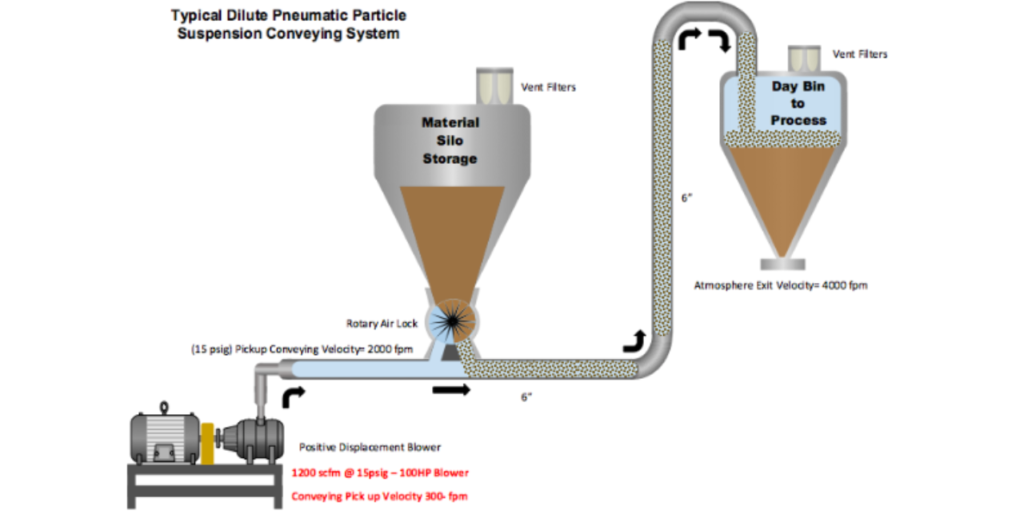
| Advantages: |
| High Conveying Speed: Dilute Phase Pressure Conveying can achieve high conveying speeds, making it suitable for long-distance transport. |
| Material Homogeneity: It ensures good material mixing during transport, reducing the risk of segregation. |
| Clean Transport: The system effectively controls dust emissions, maintaining a clean and safe working environment. |
| Versatility: This method can handle a wide range of bulk materials, including powders, granules, and pellets. |
| Disadvantages: |
| Pipeline Wear: The high-velocity flow can lead to increased wear and abrasion of the pipeline and components. |
| Limited Distance: It may not be suitable for very long-distance conveying due to pressure drop considerations. |
| Energy Consumption: The use of compressed air or gas can result in higher energy consumption compared to other conveying methods. |

| Applications: |
| Dilute Phase Pressure Conveying is used in various industries and applications, including: |
| Food Processing: For conveying food ingredients, spices, and powders. |
| Chemical Industry: In the transport of bulk chemicals, resins, and additives. |
| Plastics and Rubber: For conveying plastic pellets, granules, and rubber compounds. |
| Pharmaceuticals: In the transport of pharmaceutical powders and ingredients. |
| Agriculture: For handling grains, seeds, and fertilizers. |
| Minerals and Mining: In the transport of minerals, ores, and aggregates. |
| Materials of Construction (MOC): |
| The choice of materials for Dilute Phase Pressure Conveying systems depends on factors such as the type of material being handled, environmental conditions, and durability requirements. Common materials of construction include: |
| Stainless Steel: Suitable for industries requiring corrosion resistance and hygiene, such as food and pharmaceuticals. |
| Carbon Steel: Commonly used in non-food industrial applications where corrosion resistance is not a primary concern. |
| Plastics or Coatings: Used for certain components to prevent material contamination and corrosion. |
| Summary: |
| Dilute Phase Pressure Conveying is a pneumatic conveying method that transports bulk materials in a dilute suspension within a high-velocity airstream. It offers advantages such as high conveying speed, material homogeneity, and cleanliness. However, it has considerations like pipeline wear, limited distance capability, and higher energy consumption. The choice of equipment and materials of construction depends on specific industry requirements and applications, ensuring the efficient and reliable transport of bulk materials. |
B. Dilute Phase Vacuum Conveying
| Dilute Phase Vacuum Conveying is a pneumatic conveying method used to transport bulk materials, typically in powdered or granulated form, through a pipeline using a vacuum created by a vacuum pump or an ejector system. This method is characterized by a low material-to-air ratio, meaning that the conveyed material is carried in a relatively dilute suspension within the airstream created by the vacuum. Here’s a detailed overview of Dilute Phase Vacuum Conveying, including its working principles, advantages, disadvantages, applications, materials of construction (MOC), and a summary: |
| Working Principles: |
| Dilute Phase Vacuum Conveying operates on the principle of creating a vacuum within a closed conveying system to transport bulk materials. The typical working principles involve the following steps: |
| Material Pickup: The bulk material is picked up from a source, such as a storage bin or hopper, using a pickup point, which may be a rotary valve, venturi nozzle, or pickup wand. |
| Material Injection: The material is injected into the high-velocity airstream generated by the vacuum source, which creates a low-pressure zone. |
| Air Material Mixture: The material is entrained and suspended within the airstream due to the low pressure, creating a dilute phase mixture. |
| Transportation: The material is transported through the pipeline at high speeds, carried by the turbulent airstream created by the vacuum. |
| Material Separation: At the destination point, air filters or separators are used to separate the conveyed material from the air stream. |
| Material Discharge: The material is discharged from the system into a storage silo, processing equipment, or packaging line. |
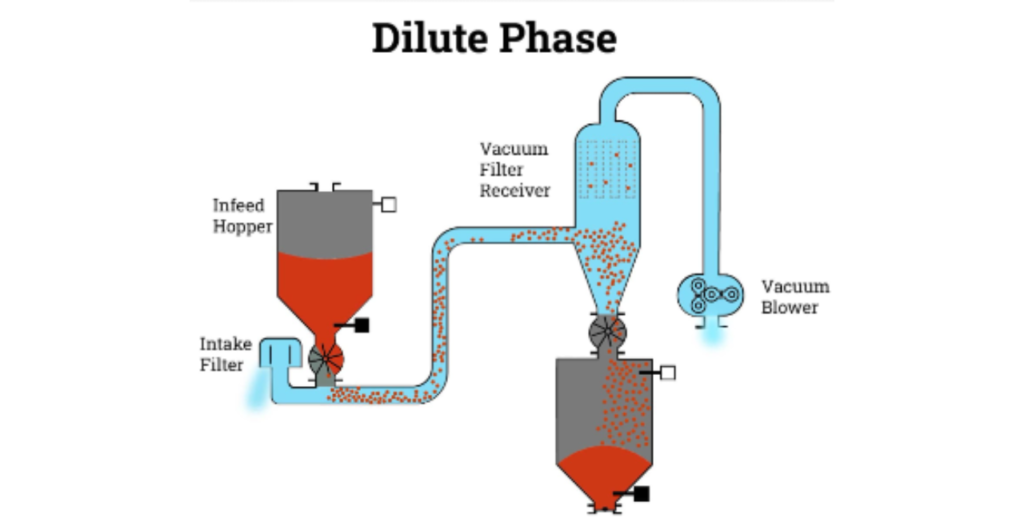
| Advantages: |
| Efficiency: Dilute Phase Vacuum Conveying can efficiently transport bulk materials over short to moderate distances, making it suitable for various applications. |
| Clean Transport: The system effectively controls dust emissions, maintaining a clean and safe working environment. |
| Material Homogeneity: It ensures good material mixing during transport, reducing the risk of segregation. |
| Versatility: This method can handle a wide range of bulk materials, including powders, granules, and pellets. |
| Disadvantages: |
| Limited Distance: It may not be suitable for very long-distance conveying due to pressure drop considerations. |
| Material Degradation: The high-velocity flow can cause material degradation or attrition, especially for fragile materials. |
| Energy Consumption: The use of vacuum pumps or ejector systems can result in higher energy consumption compared to other conveying methods. |

| Applications: |
| Dilute Phase Vacuum Conveying is used in various industries and applications, including: |
| Food Processing: For conveying food ingredients, spices, and powders. |
| Pharmaceuticals: In the transport of pharmaceutical powders and ingredients. |
| Plastics and Rubber: For conveying plastic pellets, granules, and rubber compounds. |
| Chemical Industry: In the transport of bulk chemicals, resins, and additives. |
| Agriculture: For handling grains, seeds, and fertilizers. |
| Minerals and Mining: In the transport of minerals, ores, and aggregates. |
| Materials of Construction (MOC): |
| The choice of materials for Dilute Phase Vacuum Conveying systems depends on factors such as the type of material being handled, environmental conditions, and durability requirements. Common materials of construction include: |
| Stainless Steel: Suitable for industries requiring corrosion resistance and hygiene, such as food and pharmaceuticals. |
| Carbon Steel: Commonly used in non-food industrial applications where corrosion resistance is not a primary concern. |
| Plastics or Coatings: Used for certain components to prevent material contamination and corrosion. |
| Summary: |
| Dilute Phase Vacuum Conveying is a pneumatic conveying method that transports bulk materials in a dilute suspension within a high-velocity airstream created by a vacuum source. It offers advantages such as efficiency, cleanliness, material homogeneity, and versatility. However, it has considerations like limited distance capability, material degradation, and higher energy consumption. The choice of equipment and materials of construction depends on specific industry requirements and applications, ensuring the efficient and reliable transport of bulk materials. |
c. Dense Phase Pressure Conveying
| Working Principles: |
| Dense Phase Pressure Conveying operates on the principle of using high-pressure air or gas to push or slug bulk materials through a pipeline. The typical working principles involve the following steps: |
| Material Pickup: The bulk material is picked up from a source, such as a storage bin or hopper, using a pickup point, which may be a rotary valve or venturi nozzle. |
| Material Injection: The material is injected into the pipeline, and a high-pressure air or gas stream is introduced behind it. |
| Material Transport: The material is pushed through the pipeline in a slug or plug form, moving as a cohesive mass without being suspended in the air. |
| Material Separation: At the destination point, air filters or separators are used to separate the conveyed material from the air stream. |
| Material Discharge: The material is discharged from the system into a storage silo, processing equipment, or packaging line. |
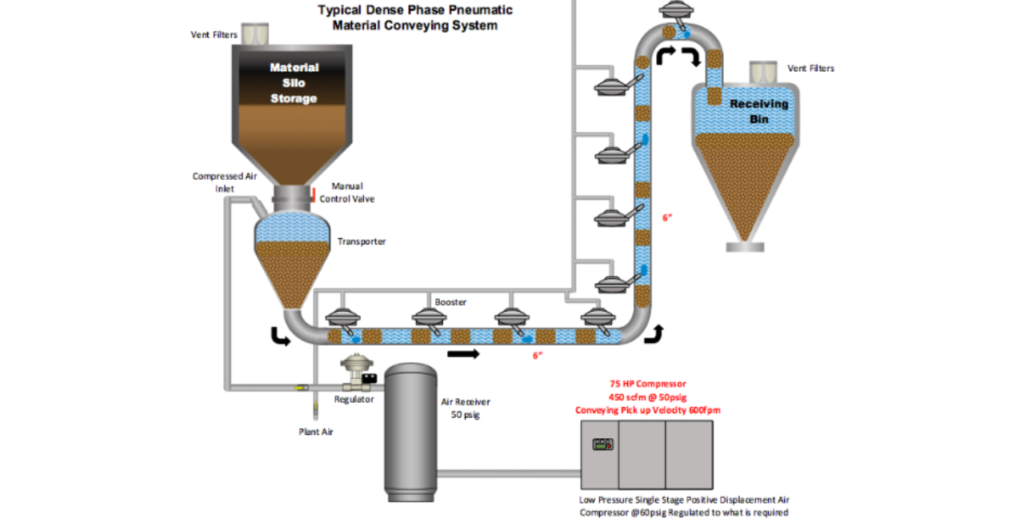
| Advantages: |
| Gentle Material Handling: Dense Phase Pressure Conveying is gentle on the conveyed material, making it suitable for fragile or abrasive materials. |
| Minimal Material Degradation: This method typically results in less material attrition and degradation compared to dilute phase conveying. |
| Reduced Air Consumption: Dense phase conveying systems generally require less compressed air or gas, leading to lower energy consumption. |
| Suitable for Long Distances: It can effectively transport materials over longer distances compared to dilute phase conveying. |
| Disadvantages: |
| Limited Conveying Capacity: Dense phase systems may have lower conveying capacities compared to dilute phase systems for the same pipeline diameter. |
| Higher Initial Cost: The equipment required for dense phase conveying can be more expensive to purchase and install. |
| More Complex Design: Dense phase systems often require more complex pipeline designs and controls. |
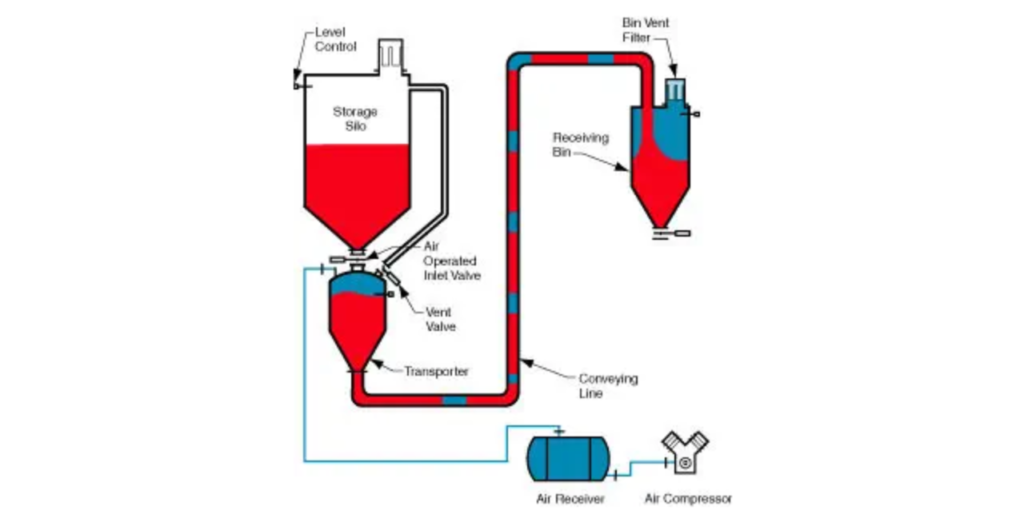
| Applications: |
| Dense Phase Pressure Conveying is used in various industries and applications, including: |
| Minerals and Mining: For conveying minerals, ores, and aggregates. |
| Chemical Industry: In the transport of bulk chemicals, powders, and resins. |
| Pharmaceuticals: For handling pharmaceutical powders and ingredients. |
| Food Processing: In the conveyance of food ingredients, including spices and powders. |
| Plastics and Rubber: For conveying plastic pellets, granules, and rubber compounds. |
| Agriculture: In the transport of grains, seeds, and fertilizers. |
| Materials of Construction (MOC): |
| The choice of materials for Dense Phase Pressure Conveying systems depends on factors such as the type of material being handled, environmental conditions, and durability requirements. Common materials of construction include: |
| Carbon Steel: Suitable for non-food industrial applications where corrosion resistance is not a primary concern. |
| Stainless Steel: Used in industries requiring corrosion resistance and hygiene, such as food and pharmaceuticals. |
| Plastics or Coatings: Employed for certain components to prevent material contamination and corrosion. |
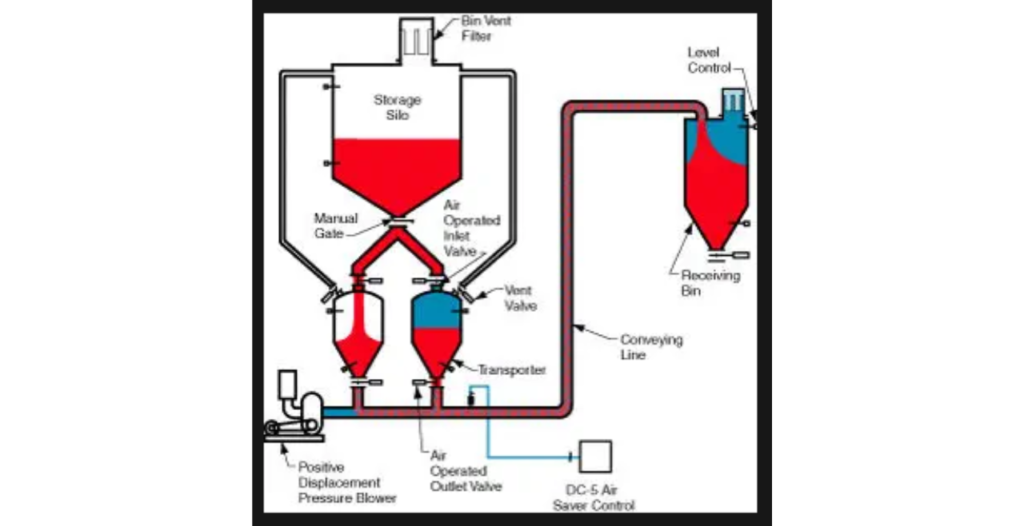
Summary:
Dense Phase Pressure Conveying is a pneumatic conveying method that transports bulk materials in a concentrated, non-suspended state through a high-pressure air or gas stream. It offers advantages such as gentle material handling, reduced material degradation, lower air consumption, and suitability for long distances. However, it has considerations like limited conveying capacity, higher initial cost, and more complex design. The choice of equipment and materials of construction depends on specific industry requirements and applications, ensuring the efficient and reliable transport of bulk materials.
D. Dense Vacuum Pressure Conveying
| Dense Phase Vacuum Conveying is a pneumatic conveying method used to transport bulk materials, typically in powdered or granulated form, through a pipeline using a vacuum created by a vacuum pump or ejector system. This method is characterized by a low material-to-air ratio, meaning that the conveyed material moves in a concentrated, non-suspended state. Dense Phase Vacuum Conveying is particularly suited for applications where material degradation or separation from the air stream must be minimized. Here’s a detailed overview of Dense Phase Vacuum Conveying, including its working principles, advantages, disadvantages, applications, materials of construction (MOC), and a summary: |
| Working Principles: |
| Dense Phase Vacuum Conveying operates on the principle of creating a vacuum within a closed conveying system to transport bulk materials. The typical working principles involve the following steps: |
| Material Pickup: The bulk material is picked up from a source, such as a storage bin or hopper, using a pickup point, which may be a rotary valve or venturi nozzle. |
| Material Injection: The material is injected into the pipeline, and a vacuum is created downstream by a vacuum pump or ejector system. |
| Material Transport: The material is pushed through the pipeline in a slug or plug form, moving as a cohesive mass without being suspended in the air. |
| Material Separation: At the destination point, air filters or separators are used to separate the conveyed material from the air stream. |
| Material Discharge: The material is discharged from the system into a storage silo, processing equipment, or packaging line. |
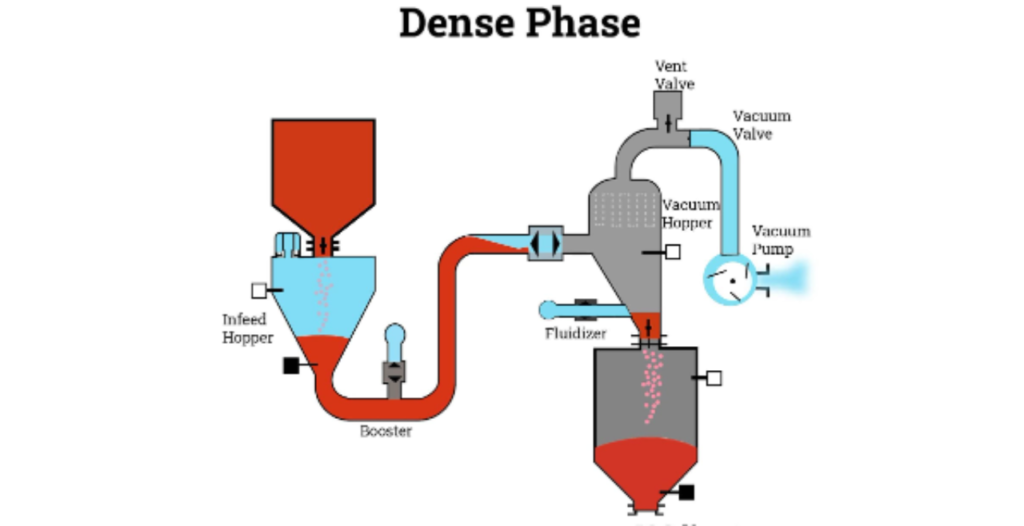
| Advantages: |
| Gentle Material Handling: Dense Phase Vacuum Conveying is gentle on the conveyed material, making it suitable for fragile or abrasive materials. |
| Minimal Material Degradation: This method typically results in less material attrition and degradation compared to dilute phase conveying. |
| Reduced Air Consumption: Dense phase vacuum conveying systems generally require less compressed air or gas, leading to lower energy consumption. |
| Clean Transport: The system effectively controls dust emissions, maintaining a clean and safe working environment. |
| Disadvantages: |
| Higher Initial Cost: The equipment required for dense phase vacuum conveying can be more expensive to purchase and install. |
| Limited Conveying Capacity: Dense phase systems may have lower conveying capacities compared to dilute phase systems for the same pipeline diameter. |
| Complex Design: Dense phase vacuum systems often require more complex pipeline designs and controls. |
| Applications: |
| Dense Phase Vacuum Conveying is used in various industries and applications, including: |
| Pharmaceuticals: For handling pharmaceutical powders and ingredients. |
| Chemical Industry: In the transport of bulk chemicals, powders, and resins. |
| Food Processing: In the conveyance of food ingredients, including spices and powders. |
| Plastics and Rubber: For conveying plastic pellets, granules, and rubber compounds. |
| Agriculture: In the transport of grains, seeds, and fertilizers. |
| Materials of Construction (MOC): |
| The choice of materials for Dense Phase Vacuum Conveying systems depends on factors such as the type of material being handled, environmental conditions, and durability requirements. Common materials of construction include: |
| Carbon Steel: Suitable for non-food industrial applications where corrosion resistance is not a primary concern. |
| Stainless Steel: Used in industries requiring corrosion resistance and hygiene, such as food and pharmaceuticals. |
| Plastics or Coatings: Employed for certain components to prevent material contamination and corrosion. |
| Summary: |
| Dense Phase Vacuum Conveying is a pneumatic conveying method that transports bulk materials in a concentrated, non-suspended state through a vacuum created by a vacuum pump or ejector system. It offers advantages such as gentle material handling, reduced material degradation, lower air consumption, and clean transport. However, it has considerations like higher initial cost, limited conveying capacity, and complex design. The choice of equipment and materials of construction depends on specific industry requirements and applications, ensuring the efficient and reliable transport of bulk materials. |
E. Powder Transfer System (PTS)
| A Powder Transfer System is a specialized equipment used to move powdered or granular materials between various processing stages or containers in a manufacturing or processing facility. These systems are designed to ensure efficient, clean, and precise transfer of powders or granules, minimizing material loss and contamination. Here’s a detailed overview of Powder Transfer Systems, including their working principles, advantages, disadvantages, applications, materials of construction (MOC), and a summary: |
| Working Principles: |
| Powder Transfer Systems operate based on a combination of mechanical, pneumatic, or vacuum principles, depending on the specific system design. Here’s a general overview: |
| Material Pickup: The system starts by picking up the powdered or granular material from a source, such as a hopper, bin, or container. |
| Conveyance: The material is then transported through a closed pipeline or tubing system. The means of conveyance can vary and include mechanical augers, screw conveyors, pneumatic conveyors, or vacuum systems. |
| Material Control: Powder Transfer Systems are equipped with controls that enable operators to regulate the flow and discharge of the material, ensuring precise transfer. |
| Material Discharge: The material is discharged at the desired destination, such as a storage vessel, mixer, or packaging machine. |

| Advantages: |
| Efficiency: Powder Transfer Systems are highly efficient and minimize material waste and spillage during transfer. |
| Cleanliness: These systems are designed to maintain a clean working environment by reducing dust emissions and contamination risks. |
| Precision: Operators can control the flow rate and destination of the material, ensuring precise transfer. |
| Reduced Labor: Automation of the transfer process reduces the need for manual labor. |
| Disadvantages: |
| Cost: The initial cost of purchasing and installing a Powder Transfer System can be significant. |
| Maintenance: Regular maintenance is required to ensure the reliable operation of the equipment. |
| Complexity: Some systems can be complex to operate and may require skilled personnel. |
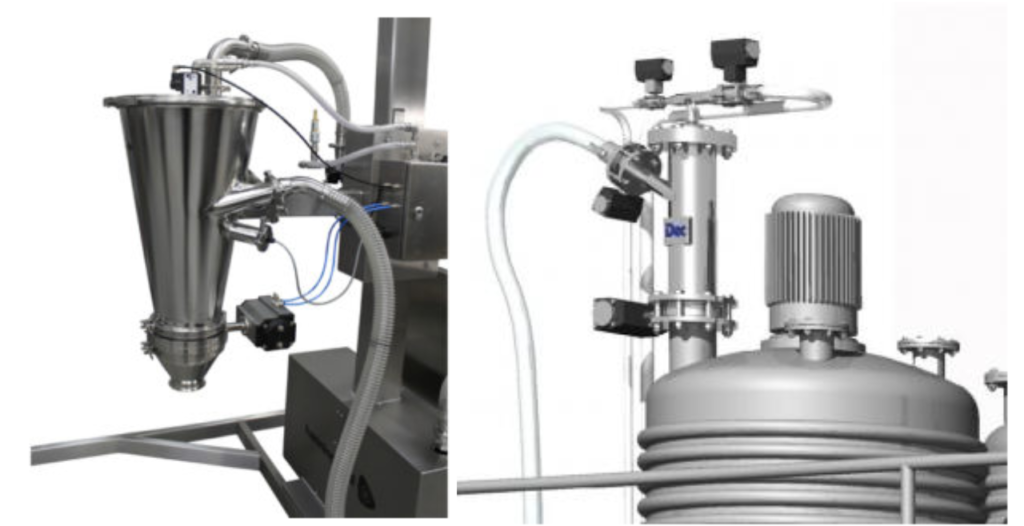
| Applications: |
| Powder Transfer Systems find applications in various industries, including: |
| Food and Beverage: For transferring ingredients like flour, sugar, and spices. |
| Pharmaceuticals: In the transfer of pharmaceutical powders and granules. |
| Chemicals: For conveying bulk chemicals and additives. |
| Cosmetics: In the production of cosmetic powders. |
| Plastics and Polymers: For transporting plastic granules and powders. |
| Agriculture: In the handling of fertilizers and agricultural powders. |
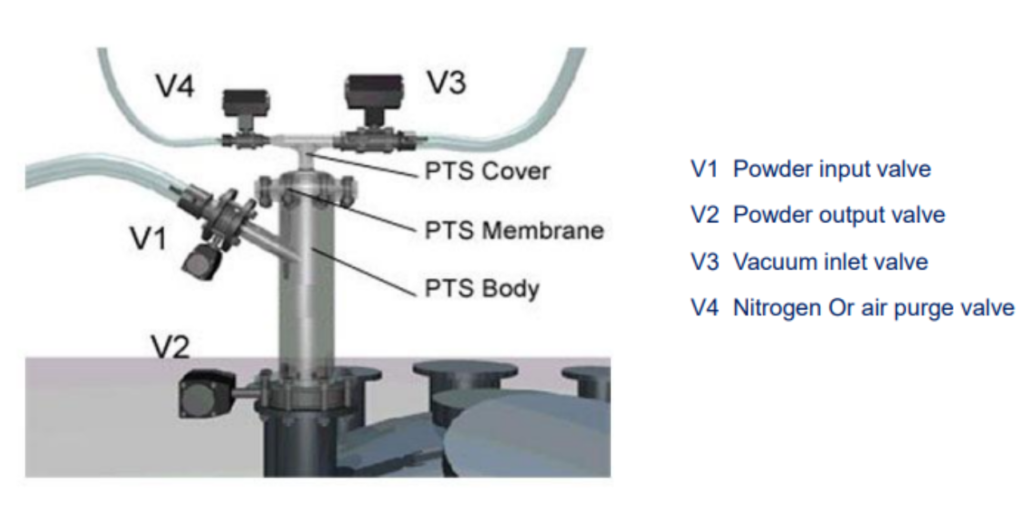
| Materials of Construction (MOC): |
| The choice of materials for Powder Transfer Systems depends on factors such as the type of material being handled, environmental conditions, and hygiene requirements. Common materials of construction include: |
| Stainless Steel: Suitable for industries requiring corrosion resistance and hygiene, such as food and pharmaceuticals. |
| Carbon Steel: Commonly used in non-food industrial applications where corrosion resistance is not a primary concern. |
| Plastics or Coatings: Used for certain components to prevent material contamination and corrosion. |

Summary:
A Powder Transfer System is a specialized equipment designed for the efficient and precise transfer of powdered or granular materials within processing
F. Portable Vacuum Powder Collection System
| A Portable Vacuum Powder Collection System, also known as a portable industrial vacuum cleaner, is a specialized piece of equipment designed for the efficient and thorough collection of fine powders and dust from various surfaces, equipment, and environments. These systems are mobile and versatile, making them suitable for a wide range of industrial applications. Here’s a detailed overview of Portable Vacuum Powder Collection Systems, including their working principles, advantages, disadvantages, applications, materials of construction (MOC), and a summary: |
| Working Principles: |
| The working principles of a Portable Vacuum Powder Collection System are relatively straightforward: |
| Suction: The system uses a powerful vacuum pump to create a strong suction force. |
| Collection Nozzle: A collection nozzle or hose is used to direct the suction to the area where powders or dust need to be collected. |
| Filtration: The collected air and powders are drawn into the system’s filtration unit, which is equipped with high-efficiency filters designed to capture fine particles. |
| Storage: The collected powders and dust are stored in a collection container or bag within the system. |
| Disposal: Once the collection container is full, it can be emptied and the collected material can be disposed of properly. |
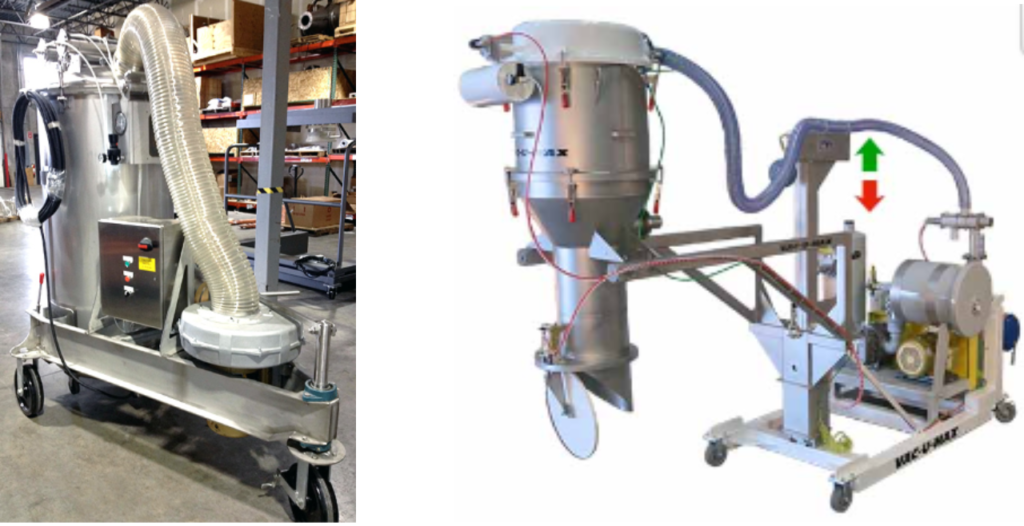
| Advantages: |
| Effective Dust Control: Portable vacuum systems effectively capture and control dust, helping maintain a clean and safe working environment. |
| Versatility: They can be used in various industrial settings, including manufacturing, construction, woodworking, and pharmaceuticals. |
| Mobility: Portability allows for easy maneuverability and access to confined or hard-to-reach areas. |
| Improved Air Quality: These systems contribute to better air quality by reducing airborne dust and particulate matter. |
| Reduced Manual Labor: They minimize the need for manual cleaning and reduce worker exposure to dust and harmful particles. |
| Disadvantages: |
| Limited Capacity: Portable vacuum systems have limited collection capacities compared to central industrial vacuum systems. |
| Regular Maintenance: Filters and collection containers must be regularly checked and cleaned or replaced, increasing maintenance requirements. |
| Power Source: These systems require a reliable power source, which may not always be available in certain industrial settings. |
| Applications: |
| Portable Vacuum Powder Collection Systems are used in a wide range of industrial applications, including: |
| Manufacturing: Cleaning and maintaining machinery, collecting spilled powders, and improving air quality in production areas. |
| Construction: Removing dust and debris from construction sites, including concrete dust and drywall dust. |
| Woodworking: Cleaning sawdust and wood chips from workshop floors and equipment. |
| Pharmaceuticals: Collecting powders and dust generated during the manufacturing process to maintain a clean and compliant workspace. |
| Food and Beverage: Cleaning up flour, sugar, spices, and other food ingredients in food processing facilities. |
| Materials of Construction (MOC): |
| The choice of materials for Portable Vacuum Powder Collection Systems depends on factors such as the type of materials being collected, environmental conditions, and durability requirements. Common materials of construction include: |
| Stainless Steel: Suitable for industries requiring corrosion resistance and hygiene, such as food and pharmaceuticals. |
| Carbon Steel: Commonly used in non-food industrial applications where corrosion resistance is not a primary concern. |
| Plastics: Used for certain components to prevent material contamination and corrosion. |
| Summary: |
| Portable Vacuum Powder Collection Systems are versatile and effective tools for capturing and controlling fine powders and dust in industrial settings. They offer advantages such as effective dust control, versatility, mobility, improved air quality, and reduced manual labor. However, they have limitations related to capacity, maintenance, and power requirements. The choice of equipment and materials of construction depends on specific industrial requirements, ensuring efficient and safe powder and dust collection. |
G. Venturi-Based Pneumatic Conveying System
| A Venturi-Based Pneumatic Conveying System is a type of pneumatic conveying system that uses a Venturi injector to create a vacuum or suction force, enabling the transfer of bulk materials, typically in powdered or granulated form, through a pipeline. This system is known for its ability to efficiently transport materials over long distances and to different destinations within a processing facility. Here’s a detailed overview of Venturi-Based Pneumatic Conveying Systems, including their working principles, advantages, disadvantages, applications, materials of construction (MOC), and a summary: |
| Working Principles: |
| The working principles of a Venturi-Based Pneumatic Conveying System involve the following steps: |
| Material Pickup: The system starts by picking up the powdered or granular material from a source, such as a storage bin or hopper. |
| Material Injection: The material is then injected into a high-velocity air or gas stream generated by a Venturi injector. |
| Air Material Mixture: As the material is injected, it becomes entrained and suspended within the high-velocity airstream. This creates a dilute phase mixture. |
| Transportation: The material is transported through the pipeline at high speeds, carried by the turbulent airstream created by the Venturi injector. |
| Material Separation: At the destination point, air filters or separators are used to separate the conveyed material from the air stream. |
| Material Discharge: The material is discharged from the system into a storage silo, processing equipment, or packaging line. |
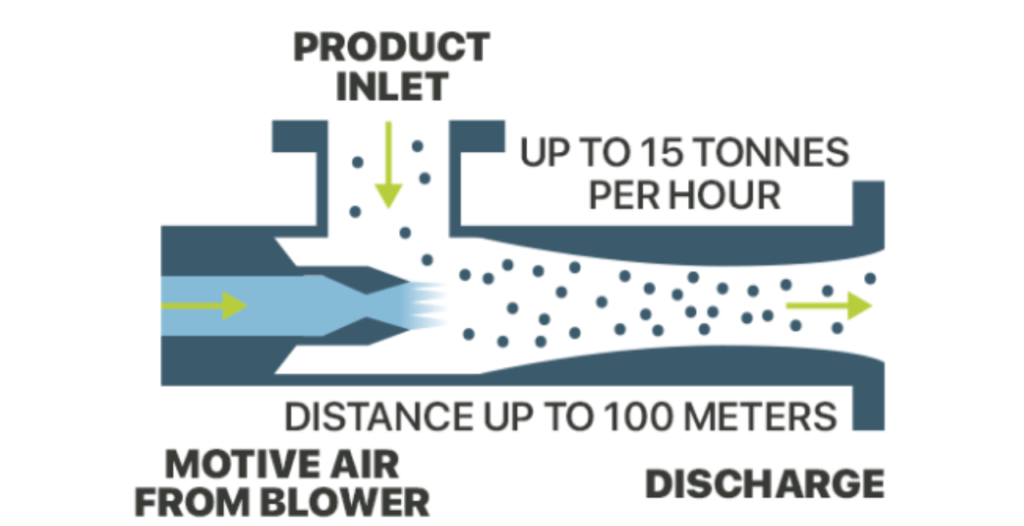
| Advantages: |
| Efficient Long-Distance Transport: Venturi-Based systems are known for their efficiency in transporting materials over long distances with minimal degradation. |
| Reduced Material Degradation: Compared to some other pneumatic conveying methods, these systems can result in less material attrition and degradation. |
| Clean Transport: They effectively control dust emissions, maintaining a clean and safe working environment. |
| Versatility: Venturi-Based systems can handle a wide range of bulk materials, including powders, granules, and pellets. |
| Disadvantages: |
| Energy Consumption: The use of compressed air or gas to generate the vacuum can result in higher energy consumption compared to other conveying methods. |
| Complex Design: These systems often require a more complex pipeline design, including Venturi injectors and controls. |
| Maintenance: Regular maintenance is required to ensure the reliable operation of the Venturi injector and filters. |

| Applications: |
| Venturi-Based Pneumatic Conveying Systems are used in various industries and applications, including: |
| Food Processing: For conveying food ingredients, spices, and powders. |
| Pharmaceuticals: In the transport of pharmaceutical powders and ingredients. |
| Plastics and Rubber: For conveying plastic pellets, granules, and rubber compounds. |
| Chemical Industry: In the transport of bulk chemicals, resins, and additives. |
| Agriculture: For handling grains, seeds, and fertilizers. |
| Minerals and Mining: In the transport of minerals, ores, and aggregates. |
| Materials of Construction (MOC): |
| The choice of materials for Venturi-Based Pneumatic Conveying Systems depends on factors such as the type of material being handled, environmental conditions, and durability requirements. Common materials of construction include: |
| Stainless Steel: Suitable for industries requiring corrosion resistance and hygiene, such as food and pharmaceuticals. |
| Carbon Steel: Commonly used in non-food industrial applications where corrosion resistance is not a primary concern. |
| Plastics or Coatings: Used for certain components to prevent material contamination and corrosion. |
| Summary: |
| Venturi-Based Pneumatic Conveying Systems use a Venturi injector to create a vacuum that transports bulk materials in a dilute suspension within a high-velocity airstream. They are efficient for long-distance transport, minimize material degradation, and maintain a clean working environment. However, they have considerations like higher energy consumption, complex design, and maintenance requirements. The choice of equipment and materials of construction depends on specific industry requirements and applications, ensuring the efficient and reliable transport of bulk materials. |
H. Cyclone Separator and Scrubber System
| A Cyclone Separator and Scrubber System is a combination of two distinct but complementary devices used in various industrial applications to separate particulate matter (dust or particles) from a gas stream and to scrub contaminants from gas. Here’s a detailed overview of the Cyclone Separator and Scrubber System, including their working principles, advantages, disadvantages, applications, materials of construction (MOC), and a summary: | |||||||
| Working Principles: | |||||||
| Cyclone Separator: | |||||||
| Inlet: The polluted gas stream, often laden with dust or particles, enters the cyclone separator tangentially at the top. | |||||||
| Centrifugal Force: The gas inside the cyclone moves in a spiral motion due to its tangential entry. This spiral motion generates centrifugal force, which pushes the heavier particulate matter outward toward the cyclone’s walls. | |||||||
| Separation: As the gas continues to spiral downward, the centrifugal force separates the particulate matter from the gas stream. The separated particles collect at the bottom of the cyclone, forming a cone-shaped hopper. | |||||||
Clean Gas Outlet: The cleaned gas exits the cyclone through an outlet at the top, free of most of the particulate matter.
|
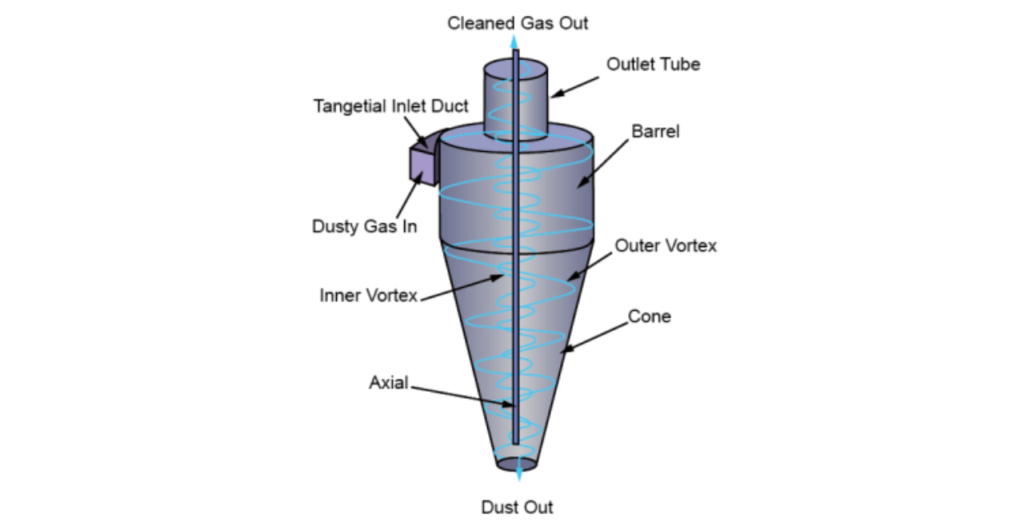
| Advantages: |
| Effective Particle Removal: Cyclone separators are highly efficient at removing particulate matter from gas streams. |
| Low Maintenance: Cyclone separators have few moving parts and are relatively low-maintenance devices. |
| Cost-Efficient: They are cost-effective for coarse particle separation and are suitable for high-temperature applications. |
| Scrubber Efficiency: Scrubber systems can efficiently remove acidic gases, particulates, and other contaminants from gas streams. |
| Versatility: The combined system is versatile and can be adapted for various industrial applications. |
| Disadvantages: |
| Limited for Fine Particles: Cyclone separators are less effective at removing very fine particles, which may require additional filtration. |
| Energy Consumption: Scrubber systems can consume energy for pumping and recirculating scrubbing liquids. |
| Chemical Handling: The use of chemical scrubbing solutions requires careful handling and disposal considerations. |
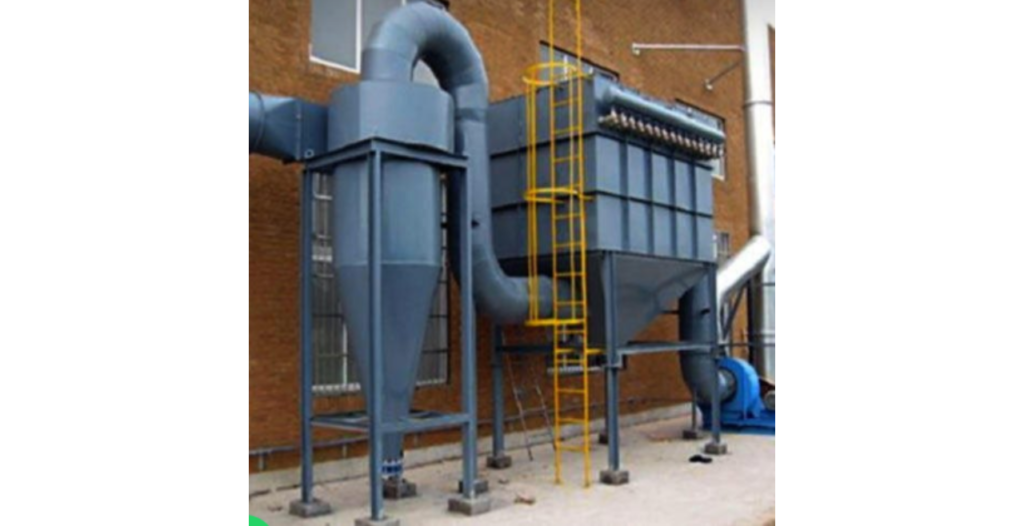
| Applications: |
| Cyclone Separator and Scrubber Systems are used in several industries and applications, including: |
| Air Pollution Control: To remove particulate matter and contaminants from exhaust gases, as in industrial boilers and incinerators. |
| Chemical Processing: For gas cleaning and removing corrosive or hazardous gases. |
| Mining and Metallurgy: To control dust emissions and remove particulate matter from ore processing. |
| Power Plants: In flue gas desulfurization (FGD) systems to remove sulfur dioxide (SO2) emissions. |
| Oil and Gas: To separate gas and liquid phases, control emissions, and purify process gases. |
| Materials of Construction (MOC): |
| The choice of materials for Cyclone Separator and Scrubber Systems depends on factors such as the type of gas, the presence of corrosive elements, and temperature requirements. Common materials of construction include: |
| Stainless Steel: Suitable for many applications due to its corrosion resistance and durability. |
| Carbon Steel: Commonly used for non-corrosive applications. |
| Specialty Alloys: For high-temperature or corrosive gas streams. |
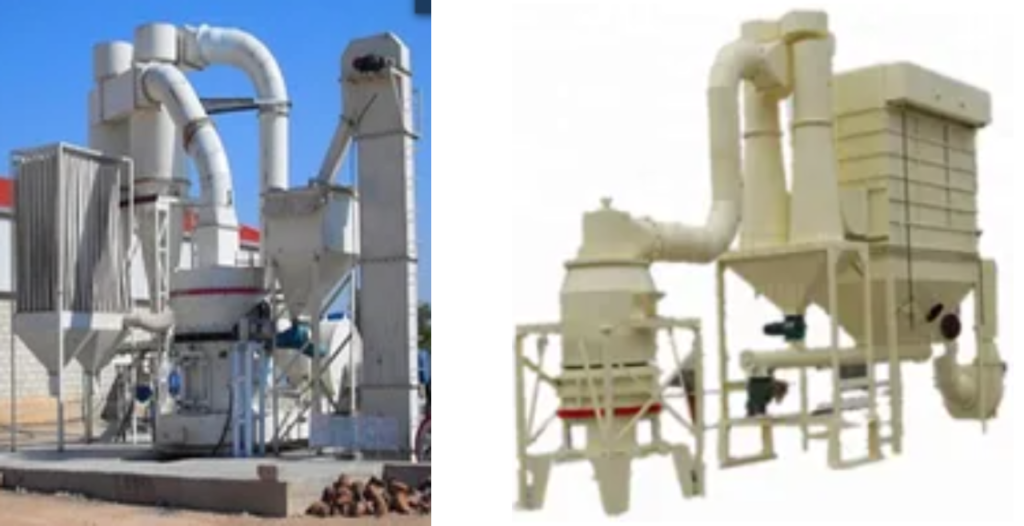
Summary:
A Cyclone Separator and Scrubber System is a combined solution for separating particulate matter from gas streams using a cyclone separator and then further purifying the gas by scrubbing out contaminants. It is an effective solution for air pollution control, gas cleaning, and removing fine particulates and harmful gases from industrial processes. While it has advantages such as efficiency and low maintenance, it also has limitations, including its effectiveness with very fine particles and energy consumption in scrubbing systems. The choice of materials and system design depends on specific industrial requirements and applications, ensuring efficient gas cleaning and particle separation.
I. Closed Loop Pneumatic Conveying System
| A Closed Loop Pneumatic Conveying System is a specialized pneumatic conveying system used to transport bulk materials, typically in powdered or granulated form, within a closed and controlled environment. Unlike open systems, closed loop systems maintain a sealed pipeline, which can offer several advantages for specific applications. Here’s a detailed overview of Closed Loop Pneumatic Conveying Systems, including their working principles, advantages, disadvantages, applications, materials of construction (MOC), and a summary: |
| Working Principles: |
| Closed Loop Pneumatic Conveying Systems operate based on the principles of creating a closed and controlled environment within a pipeline to transport materials. Here’s how they work: |
| Material Pickup: The bulk material is picked up from a source, such as a storage bin or hopper, using a pickup point, which may be a rotary valve or venturi nozzle. |
| Material Injection: The material is injected into the closed pipeline, and a gas (typically air or an inert gas) is introduced behind it. |
| Material Transport: The material is transported through the closed pipeline in a controlled and sealed environment, preventing exposure to the surrounding atmosphere. |
| Material Separation: At the destination point, air filters or separators are used to separate the conveyed material from the closed loop gas. |
| Material Discharge: The material is discharged from the system into a storage silo, processing equipment, or packaging line. |

| Advantages: |
| Material Containment: Closed loop systems provide excellent material containment, preventing dust emissions and minimizing material spillage. |
| Hygiene and Safety: These systems are suitable for handling hazardous or sensitive materials while maintaining a safe and clean working environment. |
| Environmental Control: Closed systems are ideal for applications where environmental control and containment are critical, such as in pharmaceuticals or chemical processing. |
| Reduced Contamination: They minimize the risk of material contamination, ensuring the integrity of the conveyed material. |
| Material Preservation: Closed systems can help preserve the properties and quality of sensitive materials. |
| Disadvantages: |
| Higher Initial Cost: Closed loop systems are typically more expensive to purchase and install compared to open systems. |
| Complex Design: They require a more complex pipeline design, including sealed connections, airlocks, and containment systems. |
| Energy Consumption: Maintaining a closed loop can require additional energy, especially if gas compression or recycling is involved. |
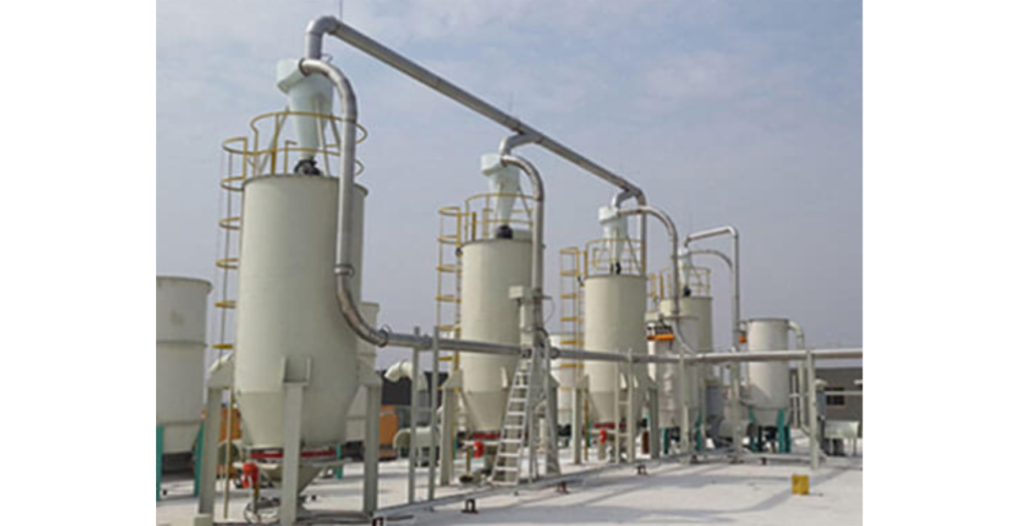
| Materials of Construction (MOC): |
| The choice of materials for Closed Loop Pneumatic Conveying Systems depends on factors such as the type of material being handled, environmental conditions, and hygiene requirements. Common materials of construction include: |
| Stainless Steel: Suitable for industries requiring corrosion resistance and hygiene, such as pharmaceuticals and food processing. |
| Carbon Steel: Commonly used in non-food industrial applications where corrosion resistance is not a primary concern. |
| Plastics or Coatings: Employed for certain components to prevent material contamination and corrosion. |
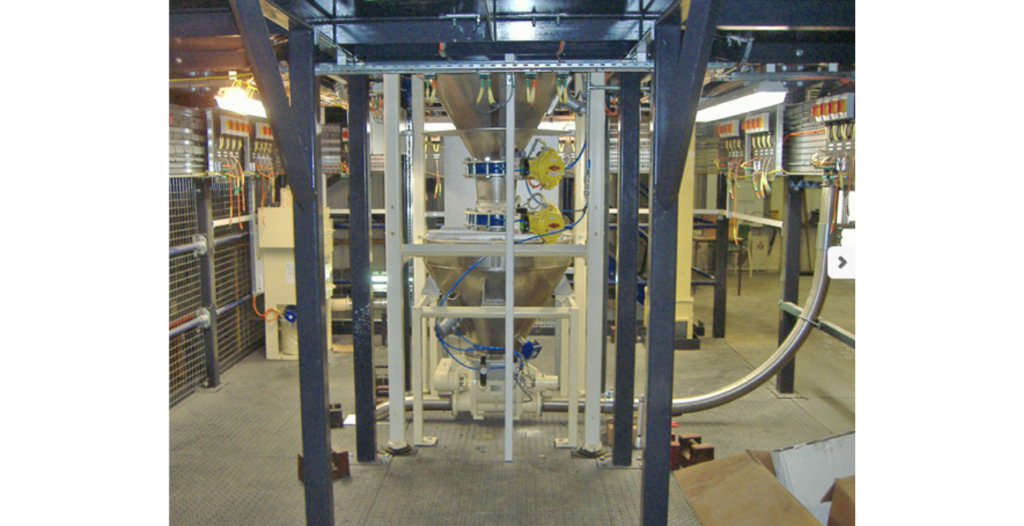
Summary:
Closed Loop Pneumatic Conveying Systems are specialized conveying systems that transport bulk materials within a sealed and controlled environment. They offer advantages such as material containment, hygiene, safety, environmental control, and reduced contamination risk. However, they come with considerations like higher initial cost, complex design, and potential energy consumption. The choice of equipment and materials of construction depends on specific industry requirements and applications, ensuring the efficient and safe transport of bulk materials in a closed environment.


 Sales & Marketing:
Sales & Marketing:  Service Supports:
Service Supports:  Website:
Website: 